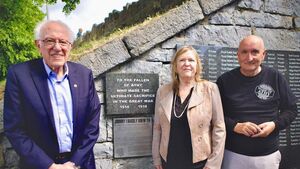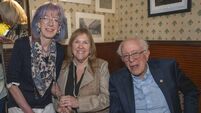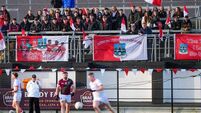The story behind 'Johnny I Hardly Knew Ye'

Bernie & Jane Sanders with Colm Walsh at the unveiling of the Made of Athy plaque in the old St Michael's cemetery
I was unable to attend the recent events in Athy held to honour the visit of Senator Bernie Sanders and his wife, Dr Jane Sanders, but by all accounts it was a resounding success.
The United States Senator from Vermont received a warm and fulsome greeting from the people of Athy.
Events commenced in the Athy Library in the former Dominican Church where local musicians Jack L and Joe Byrne treated the visitors to renditions of both and .
I understand that the State flag of Vermont flew proudly in Emily Square and the senator even had an opportunity to meet former residents of Vermont, now living in Athy, who had voted for him in the senatorial elections!
After the conclusion of the events in the library the main feature of the day was the unveiling of the ‘Made of Athy’ plaque to the anti-war song . There was a substantial crowd at the war memorial in Old St Michael’s Cemetery to witness the unveiling, blessed somewhat by the brief outbreak of sunshine between the showers on Sunday afternoon. The plaque itself is finely worded and gives an interesting context to the song and its place in our culture.
The song seems to have been composed sometime around the 1800s or possibly earlier. The song itself refers to soldiers’ service in Ceylon, modern day Sri Lanka, and indeed it seems possible to place some men from Athy who served in the army in Ceylon in and around the 1790s.
In the early summer of 1796 the troops of the First Madras European Regiment landed on the shores of Ceylon. This regiment formed part of the East India company’s private army. The company was established in London in the early 1600s to exploit the commercial opportunities which India appeared to offer to the fledging British empire.
In advancing it’s aggressive commercial expansion in India and the Far East the company founded its own private army to protect and advance its interests. The regiments in this army, particularly the Madras European Regiment, had a strong Irish presence in its ranks, particularly in the lower ranks.
At the time the regiment was garrisoned in Ceylon we know that at least two Athy men were in the regiment’s ranks, James Byrnes and John Eustace.
We know little about these two men but for the fact that they are both originally from Athy and they both enjoyed an unusually long army service. James Byrnes would serve with various regiments of the East Indian and British Army and he was discharged in 1823 at the age of 56, while John Eustace would leave the army in 1811 at the age of 53. They were the exceptions. The attrition rates amongst troops serving in India and Ceylon to disease and death were appalling and few survived the rigours of foreign service as long as Byrnes and Eustace did.
The song itself marks the return of a soldier to his home town of Athy after the vicissitudes of military service and it is quite visceral in its description of the damage wrought by the war on the body of the returning soldier.
The song’s ultimate origins are obscured by its longevity and popularity during the centuries. To Americans it is known as or and during the American Civil War it was one of the most popular songs sung by the Union troops.
Perhaps the ultimate recognition of its acceptance into the pantheon of martial music was the adaption of the song’s title for a Hollywood movie directed by the Irish-American director, John Ford, called , a story about the experience of a callow American youth at war.
While I did not have the opportunity of meeting Senator Bernie Sanders last week, it did remind me of my first trip to the United States in 1981 when my path crossed with President Richard Nixon, then in retirement.
Nixon had previously visited his ancestral home in Timahoe, Kildare in 1970 possibly with an eye on the Irish-American voters for the 1972 presidential elections.
My cousin was then working for Nixon in his private office and I returned home with a signed copy of his memoirs and a signed photograph, which hangs in my study to this day. Perhaps the closest an American President, sitting or otherwise, will ever get to Athy!






